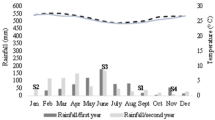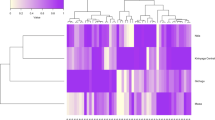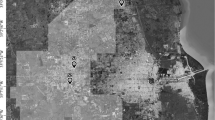Abstract
Limited and fragmented information is available about the effects of conservation agriculture, increasingly adopted by grain producers in sub-Saharan African countries, on nematode assemblages in maize-based cropping systems. Rhizosphere samples were obtained from three treatments, viz. conservation (CA) and conventional maize (CTA) fields, as well as from natural veld (NV) areas (serving as the reference) adjacent to maize fields in South African production areas. Forty-nine nematode genera (12 plant-parasitic and 37 non-parasitic/beneficial) were identified. Prominence values (PV) showed that Rotylenchulus and Meloidogyne (in descending order) dominated in 50 g roots of all three treatments, Pratylenchus in 5 g roots, and Rotylenchulus and Scutellonema in 200 g soils from CA and CTA maize, as opposed to Helicotylenchus and Rotylenchulus in soils from NV. Pratylenchus abundance in 5 g roots was significantly higher in CA and CTA maize compared to NV, with the Shannon diversity index values (H’) also being the highest for species of this genus in CA, followed by CTA and NV. Rotylenchulus abundance/50 g roots was significantly higher in CA compared to both CTA and NV, while Meloidogyne abundance/50 g roots did not differ significantly among the three treatments. For soil nematodes, the H’ was highest for NV, but not significantly compared to CA and CTA. Ninety-one percent of beneficial nematode genera and families were associated with NV soils, generally with higher PV and significant higher abundance (for bacterivores and predators) and diversity (for bacterivores, omnivores and predators) compared to CA and CTA. Nonetheless, most soils from the three treatments represented resource-depleted soil nematode communities indicating that soil health should be improved by using strategies such as cover cropping, incorporation of organic materials and inclusion of crop rotation sequences using cultivars with poor-host status or resistance to the dominating, target plant-parasitic nematode species to enable sustainable crop production. Associations of nematode assemblages, plant-parasitic and beneficial, with selected soil properties are also illustrated.



Similar content being viewed by others
References
Benkovic-Lacic T, Brmez M, Ivezic M, Raspudic E, Pribetić D, Loncaric Z, Grubisic D (2013) Influence of organic and inorganic fertilizers on nematode communities in cornfield. Bulgarian J Agr Sci 19:235–240
Bolliger A (2007) Is Zero-till an appropriate agricultural alternative for disadvanged smallholders of South Africa? A study of surrogate systems and strategies, smallholder sensitivities and soil glycoproteins. PhD Thesis, University of Cophenhagen, Copenhagen.
Bolliger A, Magid J, Amado TJC, Skóra Neto F, Ribeiro MFS, Caltegari A, Ralischs R, De Neergaard A (2006) Taking stock of the Brazilian “zero-till revolution”: a review of landmark research and farmers practice. Adv Agron 91:47–110
Bongers T (1990) The maturity index: an ecological measure of environmental disturbance based on nematode species composition. Oecologia 83:14–19
Bongers T, Bongers M (1998) Functional diversity of nematodes. Appl Soil Ecol 10:239–251
Briar S, Grewal PS, Somasekhar N, Stinner D (2007) Soil nematode community, organic matter, microbial biomass and nitrogen dynamics in field plots transitioning from conventional to organic management. Appl Soil Ecol 37:256–266. https://doi.org/10.1016/j.apsoil.2007.08.004
Briar S, Barker C, Tenuta M, Entz MH (2012) Soil nematode responses to crop management and conversion to native grasses. J Nematol 44:245–254
Carta LK, Handoo ZA, Skantar AM, Van Biljon J, Botha M (2002) Redescription of Pratylenchus teres Khan & Singh, 1974 (Nemata: Pratylenchidae) with the description of a new subspecies from South Africa, and a phylogenetic analysis of related species. Afr Plant Prot 8:13–24
Coyne DL, Cortada L, Dalzell JL, Claudius-Cole AO, Haukeland S, Luambano N, Talwana H (2018) Plant-parasitic nematodes and food security in Sub-Saharan Africa. Annu Rev Phytopathol 56:381–403
Dababat AAS, Fourie H (2018) Nematode Parasites of Cereals. Plant nematodes in tropical and subtropical agriculture. In: Sikora R, Coyne D, Hallmann J, Timper P (eds) Plant parasitic nematodes in subtropical and tropical agriculture. CAB International, Wallingford, pp. 163–221.
Daneel M, Engelbrecht E, Fourie H, Ahuja P (2018) The host status of Brassicaceae to Meloidogyne and their effects as cover and biofumigant crops on root-knot nematode populations associated with potato and tomato under South African field conditions. Crop Prot 110:198–206
De Waele D, Jordaan EM (1988) Plant-parasitic nematodes on field crops in South Africa. 1. Maize. Revue Nématologie 11:65–74
Djigal D, Chabrier C, Duyck P-F, Achard R, Quénéhervé P, Tixier P (2012) Cover crops alter the soil nematode food web in banana agroecosystems. Soil Biol Biochem 48:142–150
Du Preez CC, Van Huyssteen CW, Mnkeni PNS (2011) Land use and soil organic matter in South Africa 1: A review on spatial variability and the influence of rangeland stock production. S Afr J Sci, 107. https://doi.org/10.4102/sajs.v107i5/6.354
Du Preez GC, Daneel MS, Wepener V, Fourie H (2018) Beneficial nematodes as bioindicators of ecosystem health in irrigated soils. Appl Soil Ecol 132:155–168
Du Preez G, Daneel M, De Goede R, Du Toit MJ, Ferris H, Fourie H, Geisen S, Kakouli-Duarte T, Korthals G, Sánchez-Moreno S, Schmidt JH (2022) Nematode-based indices in soil ecology: application, utility, and future directions. Soil Biol Biochem. https://doi.org/10.1016/j.soilbio.2022.108640
Du Toit ME, Du Preez CC, Hensley M, Bennie ATP (1994) Effek van bewerking op die organiese materiaalinhoud van geselekteerde droëlandgronde in Suid-Afrika. S Afr J Plant Soil 11:71–79
FAO (2014) What is Conservation Agriculture? Available at http://www.fao.org/ag/ca/1a.html. Accessed on November, 2 2020.
Ferris H (2010) Form and function: metabolic footprints of nematodes in the soil food web. Eur J Soil Biol 46:97–104. https://doi.org/10.1016/j.ejsobi.2010.01.003
Ferris H, Bongers T (2009) Indices developed specifically for analysis of nematode assemblages. In: Wilson MJ, Kakouli-Duarte T (eds) Nematodes as environmental indicators. CAB International, Wallingford, pp 124–145
Ferris H, Venette RC, Van der Meulen HR, Lau SS (1998) Nitrogen mineralization by bacterisl-feeding nematodes: verification and measurement. Plant Soil 203:159–171
Ferris H, Bongers T, De Goede RGM (2001) A framework for soil food web diagnostics: extension of the nematode faunal analysis concept. Appl Soil Ecol 18:13–29
Fourie H, Mc Donald AH, Loots GC (2001) Plant-parasitic nematodes in field crops in South Africa. 6. Soybean. Nematology 3:447–454
Giller KE, Witter E, Corbeels M, Tittonell P (2009) Conservation agriculture and smallholder farming in Africa: the heretics view. Field Crop Res 114:23–34
Girgan C, du Preez G, Marais M, Swart A, Fourie H (2020) Nematodes and the effect of seasonality in grassland habitats of South Africa. J Nematol, 52. https://doi.org/10.21307/jofnem-2020-116
Habig J, Hassen AI, Swart A (2015) Application of microbiology in conservation agriculture. In: Farooq M, Siddique KHM (eds) Conservation agriculture. Springer International Publishing, Switzerland, pp 525–557
Handbook of Standard Soil Testing Methods for Advisory Purposes (HSST) (1990) The non-Affiliated Soil Analysis Work committee: Pretoria, Republic of South Africa.
Hooper JH, Hallmann J, Subbotin S (2005) Methods for extraction, processing and detection of plant and soil nematodes. In: Luc M, Sikora RA, Bridge J (eds) Plant parasitic nematodes in subtropical and tropical agriculture, 2nd edn. CAB International, Wallingford, pp. 53–86.
Kimenju JW, Karanja NK, Mutua GK, Rimberia BM, Wachira PM (2009) Nematode community structure as influenced by land use and intensity of cultivation. Trop Subtrop Agroecosys 11:353–360
Liang W, Lou Y, Li Q, Zhong S, Zhang X, Wang J (2009) Nematode faunal response to long-term application of nitrogen fertilizer and organic manure in Northeast China. Soil Biol Biochem 41:883–890
Madamombe S, Nyagumbo I, Mvumi B, Nyamugafata P, Wuta M, Chinheya C (2017) Nematode management in rain-fed smallholder maize production systems under conservation agriculture in Zimbabwe. Exp Agric 54:1–15. https://doi.org/10.1017/S0014479717000163
Maina S, Karuri H, Ng’endo RN (2019) Nematode soil food webs in maize agro-ecosystems and their implication on plant-parasitic nematodes. Phytoparasitic 47:743–758. https://doi.org/10.1007/s12600-019-00769-4
Marais M, Swart A, Lamprecht SC, Farina MPW, Thibaud GR, Habig JH, Bloem JF (2009) The influence of tillage on nematodes. S Afr J Sci Technol 28:165–166
Marais M, Swart A, Fourie H, Berry SD, Knoetze R, Malan A (2017) Techniques and procedures: In: Fourie H, Spaull VW, Jones RJ, Daneel MS, De Waele D (eds) Nematology in South Africa: a view from the 21st century. Springer, Cham, pp. 73–118. https://doi.org/10.1007/978-3-319-44210-5
Mashavakure N, Mashingaidze AB, Musundire R, Gandiwa E, Muposhi VK, Thierfelder C, Nhamo N, Bere T, Akhtar SS (2018) Short-term impacts of tillage and fertilizer treatments on soil and root borne nematodes and maize yield in a fine textured cambisol. J Nematol 50:329–342. https://doi.org/10.21307/jofnem-2018-033
Mbatyoti A, Daneel MS, Swart A, Marais M, De Waele D, Fourie H (2018) Terrestrial non-parasitic nematode assemblages associated with glyphosate-tolerant and conventional soybean-based cropping systems. J Nematol 50:243–260
Mc Donald AH, De Waele D, Fourie H (2017) Nematode pests of maize and other cereal crops. In: Fourie H, Spaull VW, Jones RK, Daneel MS, De Waele D (eds) Nematology in South Africa: A view from the 21st century. Springer, Cham, pp. 183–201. https://doi.org/10.1007/978-3-319-44210-5
Neher DA (1999) Nematode communities in organically and conventionally managed agricultural soils. J Nematol 31(2):142–154. PMID: 19270884; PMCID: PMC2620368
Neher DA (2001) Role of nematodes in soil health and their use as indicators. J Nematol 33:161–168
Neher DA (2010) Ecology of plant and free-living nematodes in natural and agricultural soil. Annu Rev Phytopathol 48:371–394. https://doi.org/10.1146/annurev-phyto-073009-114439
Ney L, Franklin D, Mahmud K, Cabrera M, Hancock D, Habteselassie M, Newcomer Q, Dahal S, Subedi A (2019) Sensitivity of nematode community analysis to agricultural management practices and inoculation with local effective microorganisms in the southeastern United States. Soil Syst 3(2). https://doi.org/10.3390/soilsystems3020041
Renčo M, Čerevková A, Gömöryová E (2019) Soil nematode fauna and microbial characteristics in an early-successional forest ecosystem. Forests 10:888. https://doi.org/10.3390/f10100888
Riekert HF (1995) An adapted method for extraction of root-knot nematode eggs from maize root samples. Afr Plant Prot 1:41–43
Riekert HF (1996) Economic feasibility of nematode control in dryland maize in South Africa. Afr Crop Sci J 4:477–481
Riekert HF, Henshaw GE (1998) Effect of soybean, cowpea and groundnut rotations on root-knot nematode build-up and infestation of dryland maize. Afr Crop Sci J 6:377–383
Salamun P, Kucanova E, Brazova T, Miklisova D, Renco M, Hanzelova V (2014) Diversity and food web structure of nematode communities under high soil salinity and alkaline pH. Ecotoxicology 23(8):1367–1376. https://doi.org/10.1007/s10646-014-1278-7
Salamun P, Hanzelova V, Miklisova D, Sestinova O, Findorakova L, Kovacik P (2017) The effects of vegetation cover on soil nematode communities in various biotopes disturbed by industrial emissions. Sci Total Environ 592:106–114. https://doi.org/10.1016/j.scitotenv.2017.02.238
Sánchez-Moreno S, Ferris H (2018) Nematode ecology and soil health. In: Sikora R, Coyne D, Hallmann J, Timper P (eds) Plant parasitic nematodes in subtropical and tropical agriculture. CAB International, Wallingford, pp 62–86
Sánchez-Moreno S, Smukler S, Ferris H, O’Green AT, Jackson LA (2008) Nematode diversity, food web conditions and chemical and physical properties in different soil habitats in an organic farm. Biol Fert Soils 44:727–744
Shannon CE (1948) A mathematical theory of communication. Bell Syst Tech J 27:379–423. https://doi.org/10.1002/j.1538-7305.1948.tb01338.x
Sieriebriennikov B, Ferris H, De Goede R (2014) NINJA: an automated calculation system for nematode-based biological monitoring. Eur J Soil Biol 61:90–93. https://doi.org/10.1016/j.ejsobi.2014.02.004
Singh B (2018) Are nitrogen fertilizers deleterious to soil health? Agronomy 8. https://doi.org/10.3390/agronomy8040048
Song M, Li X, Jing S, Lei L, Wang J, Wan S (2016) Responses of soil nematodes to water and nitrogen additions in an old-field grassland. Appl Soil Ecol 102:53–60
Swanepoel CM, Swanepoel LH, Smith HJ (2017) A review of conservation agriculture research in South Africa. S Afr J Plant Soil 35:1–10
Thakur MP, Del Real IM, Cesarz S, Steinauer K, Reich PB, Hobbie S, Ciobanu M, Rich R, Worm K, Eisenhauer N (2019) Soil microbial, nematode, and enzymatic responses to elevated CO2, N fertilization, warming, and reduced precipitation. Soil Biol Biochem 135:184–193. https://doi.org/10.1016/j.soilbio.2019.04.020
Waceke JW, Arim OJ, Waudo SW, Kimenju JW (2013) Plant-parasitic nematodes of maize (Zea mays L.) in low input agriculture in Kenya. Afr Crop Sci J 8:443–450
Wang K-H, Mcsorley R, Gallaher RN (2004) Relationship of soil management history and nutrient status to nematode community structure. Nematropica 34:83–95
Xu Y-Y, Lu H, Wang X, Zhang K-Q, Li G-H (2015) Effect of volatile organic compounds from bacteria on nematodes. Chem Biodivers 12:1415–1421
Yeates GW, Bird AF (1994) Some observations on the influence of agricultural practices on the nematode faunae of some South Australian soils. Fundam Appl Nematol 17:133–145
Acknowledgements
This research was partially funded by the Maize Trust of South Africa, while infrastructure was supplied by the North-West University and ARC-GC.
Author information
Authors and Affiliations
Contributions
SB conducted the experiments and together with Fourie wrote the document, while DP, MD and HF contributed towards the data analyses and editing of the document.
Corresponding author
Ethics declarations
Conflict of interest
The authors declare that they have no conflict of interest.
Additional information
Publisher's Note
Springer Nature remains neutral with regard to jurisdictional claims in published maps and institutional affiliations.
Rights and permissions
About this article
Cite this article
Bekker, S., Preez, G.D., Daneel, M. et al. Nematode assemblages in conservation and conventional maize fields: a South African baseline study. J Plant Dis Prot 129, 1235–1248 (2022). https://doi.org/10.1007/s41348-022-00619-2
Received:
Accepted:
Published:
Issue Date:
DOI: https://doi.org/10.1007/s41348-022-00619-2




